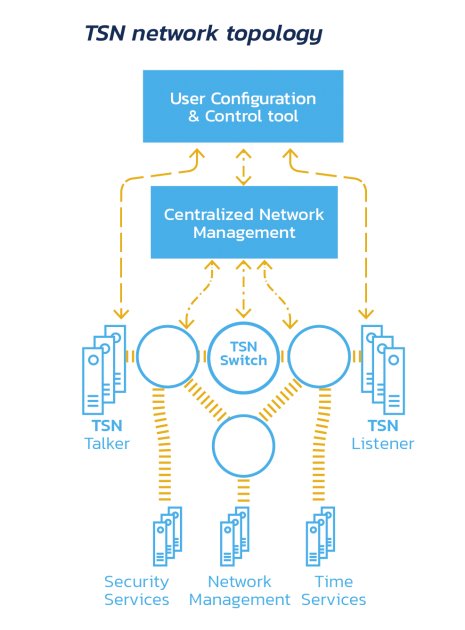- Home
- Technical Products
Enterprise Cloud IT Solutions
Test Measurement
Industrial Measurement
- Solutions
Enterprise Cloud IT Solutions
Test Measurement
- Resource Center
- About Us
 EN
EN
HPS-HSR-PRP Switch IP Kernel
Product Overview
The HSR-PRP Switch (HPS) is an IP core used to implement the High Availability Seamless Redundancy and Parallel Redundancy Protocol (HSR and PRP version 3, IEC 62439-3-clause 5 and 4 respectively) standards for reliable Ethernet communications.The HSR-PRP Switch is a complete hardware solution that can be implemented on a low-cost FPGA.
It is a flexible solution for energy market devices that will be connected to HSR rings, PRP LANs or used as bridges in an IEC 61850 environment.
The following Xilinx FPGA families support HPS:
HPS can be easily integrated into your FPGA design by utilizing the new Xilinx Vivado tool, which allows the IP core to be used in a graphical user interface and the IP parameters to be configured in an easy way.

connector
- Full-duplex 10/100/1000 Mbps Ethernet interface
- MII/RMII/GMII/RGMII/SGMII/QSGMII Physical Layer Device (PHY) Interface
- Each port supports different data rates
- Copper and fiber media interfaces: 10/100/1000Base-T, 100Base-FX, 1000Base-X
exchange
- It switches frames through hardware. This feature provides the high switching speeds necessary to realize the maximum allowable service life and data integrity of process buses and inter-frame buses for substation automation.
- Processing architecture dedicated to HSR/PRP. 500ns forwarding delay for Gigabit Ethernet.
- It is an all-hardware. No on-chip microprocessor or software stack required
- It has been optimized to require virtually no logic resources, allowing it to be implemented on low-cost FPGA devices.
- Giant Frame Management
Time Synchronization
- It supports IEEE 1588-2008 v2 with SoC-e 1588 IP core.
Configuration
- MDIO, UART, AXI4-Lite or CoE (Configuration over Ethernet) management interface
- Configuration over Ethernet (COE): Full access to internal registers via the same Ethernet link to the CPU
- Drivers are provided with the purchase of IP cores
redundancies
- It can be used to implement terminal node DAN, RedBox or QuadBox functions.
- It comes with a single marker that can be switched between PRP and HSR modes through the software.
- It includes integrated full statistics and error registers for each port (network supervisor)
- HSR-HSR, HSR-PRP supported modes for seamless PRP-HSR network merging and Quadbox operation
- VLAN Support and HSR Ring IDs
- SNMP and MIB tables available
Customizable features in the HSR-PRP switch IP core to optimize resource/function tradeoffs:
- Node Table Size
- Independent forwarding queue size for each port
- IEEE1588v2 P2P Transparent Clock in Redundant and Interconnected Ports
- Expandable Overlay/Recycling Disposal Table
- VLAN Priority Support
- Access to internal registers via AXI4-Lite, MDIO, UART or CoE (Configuration over Ethernet)
- RedBox mode with integrated SAN proxy
- IEEE 1588v2 Normal Clock, Hybrid Clock and Boundary Clock
Reference Design Supported Boards
- SoC-e SMARTzynq Brick
- Avnet I4EK HSR/PRP Kit
Keeping up with the times and innovating - Explore more potentials of TSN with Hongke
Time Sensitive Networking (TSN) is a new generation of network technology based on the evolution of the standard Ethernet architecture. It takes traditional Ethernet as the network foundation and provides a data link layer protocol specification for deterministic data transmission capability through mechanisms such as clock synchronization, data scheduling, and network configuration. Compared with traditional Ethernet, TSN can provide microsecond-level deterministic services, reduce the complexity of the entire communication network, and realize the convergence of information technology (IT) and operation technology (OT). With its precise clock synchronization, deterministic traffic scheduling, and intelligent and open operation and maintenance management framework, TSN can ensure the high-quality transmission of multiple business traffic in a common network, and it has both performance and cost advantages, and it is the development trend of the future network. This is the future trend of network development.
Currently, TSN technology has a high level of discussion in the automotive, industrial, rail transportation, and aerospace fields. As a non-vendor-bound real-time communication protocol, we believe that TSN technology has a good application prospect.
Welcome to contact us to explore and learn the integration of TSN technology with various industries, and actively promote more applications on the ground to jointly build a new world of intelligent interconnection.



